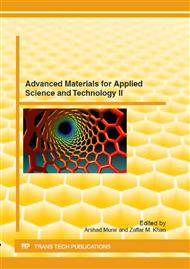p.15
p.25
p.37
p.43
p.53
p.63
p.79
p.87
p.97
Design of Tape Wound Composite Cylindrical Shells Incorporating Different Failure Criteria and Winding Kinematics
Abstract:
Internally pressurized tape wound composite shells of revolution with plugged ends are immensely utilize in commercial and aerospace applications. The focus of present endeavor is the realistic design of composite shells. A balanced symmetric stacking sequence of glass/epoxy has been considered. Its mechanical properties are determined from the experimental testing of flat plate samples as per ASTM standards. Netting analysis is then performed to find out the winding angles and hoop/helical layers contribution for optimum structural performance and higher efficiencies. The winding kinematics has been comprehended from the developed surface of the composite cylindrical shell and it has elucidated that each helical layer results from the interlacing of two plies with alternate angles of + θ and θ to the shell meridian. These helically interlaced layers are responsible for the creation of triangular shaped flip flop patterns which run both across the circumference as well as along the shell meridian. These characteristic patterns of helical winding known as mosaic patterns are not generally incorporated in the design calculations which are normally based on mechanics of composite laminates. Their pronounce effect in altering the transverse fiber stress is presented in the present study. The influence of mosaics in the presence of hoop layers is targeted for the first time hence the laminate that has been analyzed comprise of both hoop layers and helical layers with mosaic patterns. A software code has been developed in MATLAB using classical laminate plate theory (CLPT) incorporated with different failure criteria. Range of burst pressures based on different failure criteria has been plotted. Results of MATLAB code and FEA based ANSYS software, are in close agreement.
Info:
Periodical:
Pages:
53-62
Citation:
Online since:
September 2012
Authors:
Price:
Сopyright:
© 2012 Trans Tech Publications Ltd. All Rights Reserved
Share:
Citation:


